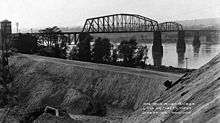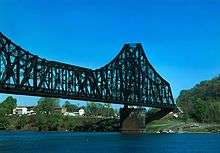Beaver Bridge (Ohio River)
| Beaver Bridge | |
|---|---|
 Beaver rail bridge seen from upriver. | |
| Coordinates | 40°41′34″N 80°17′27″W / 40.692906°N 80.290833°WCoordinates: 40°41′34″N 80°17′27″W / 40.692906°N 80.290833°W |
| Carries | Two tracks of CSX Transportation. |
| Crosses | Ohio River |
| Locale | Monaca, Pennsylvania and Beaver, Pennsylvania |
| Characteristics | |
| Design | Cantilever through truss bridge |


The Beaver Bridge is a rail bridge spanning the Ohio River between Monaca and Beaver, Pennsylvania. It consists of two spans: a southern cantilever through truss of 769 feet (234 m) with 320-foot (98 m) anchor arms; and a northern camelback through truss of 370 feet (110 m). The bridge currently carries two tracks of CSX Transportation.
The bridge was designed by Albert Lucius and built by McClintic-Marshall Company of Pittsburgh between March 1908 and May 1910 for the Pittsburgh and Lake Erie Railroad. The bridge is notable in that the railroad proceeded with the cantilever design despite the collapse of the Quebec cantilever bridge during construction in 1907. The Beaver bridge replaced a single-track bridge built in 1890, 300 feet (91 m) downstream from the current bridge's position, which itself replaced an 1878 wrought iron bridge at the same location.
See also
References
- Cook, Richard J. (1987). The Beauty of Railroad Bridges in North America -- Then and Now. Golden West Books, San Marino, California (United States). ISBN 0-87095-097-5.
External links
| Wikimedia Commons has media related to Beaver Bridge (Ohio River). |
- Monaca-Beaver Railroad Bridge at Bridges & Tunnels
- Historic American Engineering Record (HAER) No. PA-510, "Pittsburgh & Lake Erie Railroad, Ohio River Bridge", 8 photos, 2 color transparencies, 7 data pages, 1 photo caption page
- Old photos of Beaver Bridge